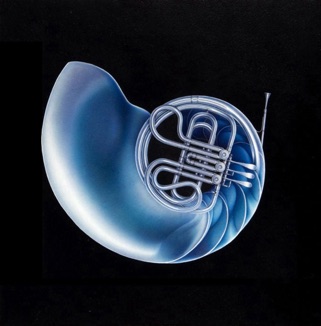
Thanks to the instrument’s natural sound characteristics the forest imagery developed further until the horn came to symbolize the expanses of nature, wide open places, visions of space, the infinite universe, mankind's yearning to explore vastness and to push forward into new dimensions.
It is hardly surprising that this multiplicity of functions gave the instrument huge significance as a symbol of communication. Today, the horn is used to express a wide variety of sometimes-contradictory emotions, from the pain of parting to the joy of arrival, from the yearning for peace to feelings of triumph.
For my composition, Callings, I attempted to capture some of these emotions.
The first movement, Call of the Sea, attempts to convey the pull of ocean surroundings. Perhaps one will conjure up languid and leisurely moments—staring out pensively over the waves, watching the seaweed sways and swirls or being delighted by the advance and retreat of sea-foam.
The second movement, Bootie Call, is lighthearted, humorous and more horn-like or “horn-y,” if you like. With the pun intended, I sought to express yearning and nature or more accurately ‘human nature.’ Perhaps one will recall the “walkin’, lookin’, lookin’ good, bein’ looked at” experience. This is, of course, hard work and the effort expended may not yield desired results leading one to just run out of energy.
The third movement, Call to Arms, speaks to the desire to defend one’s self and others in battle. Examined are the rallying cry, the esprit de corps, the triumph of victory as well as the chaos, destruction and unanswered question of whether the gain was hollow.
The fourth movement, Call for Peace, explores the universal desire to be free from strife. Beginning with resignation, variations on equality between counter-points are pursued until harmony is achieved.
The fifth and final movement, Call of the Wild, portrays the need to just do something different. Perhaps the agitated, uncontrollable impulse that lurks in all of us breaks free and pushes forward into new dimensions of exuberance that, in hindsight, was already there.